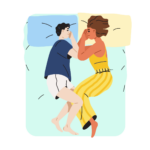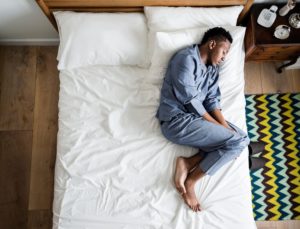Best Cuddling Positions for Sleep
Table of Contents
Sleeping while cuddled up to a bed partner can offer a sense of connection, security, and intimacy. Although researchers have yet to identify the best cuddling position for sleep, the optimal position may depend on each person’s preferred sleep position, body temperature regulation, and need for personal space.
Spooning

A common sleep position for couples, the spooning position is when each person lies on their side and faces the same direction. The back of one partner, called the little spoon, nestles into the front of the other, called the big spoon.
Since side sleeping is the most common sleep position among adults, spooning can be well suited to many people’s natural sleep preferences. Spooning is also a cozy position that may provide extra warmth for people who tend to get cold during sleep.
Back-to-Back

In this position, each person lies on their side facing opposite directions from their partner, with only their backs touching. In a survey of couples, this is the second-most common cuddling position in which to fall asleep, likely due to each partner’s autonomy and ability to move more freely.

Face-to-Face

To cuddle face-to-face, each person faces the other while lying on their sides. Couples lying in this position might also intertwine their legs. Although this position may help facilitate intimacy and communication, research suggests that this is one of the least common cuddling positions for sleep.
Head on Shoulder

Another common cuddling position is when one person lies on their back, and the other person nuzzles into them while lying on their side. One study found that this position was preferred by almost a fifth of couples surveyed. This position could be a good fit for couples who like different sleeping positions.
Classic Handhold

Holding hands can help a couple maintain physical touch in a variety of sleeping positions. This might be a great cuddling option for people who want to remain close but also need a bit of separation to fall asleep. This is especially ideal if you tend to sleep hot.
Benefits of Cuddling
Cuddling as a form of physical touch has a number of benefits for mental and physical health. Even though the benefits of specific cuddling positions have not been studied, physical touch has been shown to improve sleep quality and several other aspects of health and well-being.
Improves Sleep Quality
The precise impact of cuddling on sleep quality is still an area of scientific exploration, but some research suggests that touching a partner prior to sleep is associated with better rest . Conversely, a general lack of physical touch may lead to poorer sleep.
Additionally, just sleeping next to another person may improve sleep quality . Studies also suggest that people who share a bed with another person may get more REM sleep than people who sleep alone.
Lowers Stress
Physical touch can alter the levels of chemicals in the body associated with stress. Studies have found that touch from a loved one may reduce levels of alpha amylase and cortisol , two chemicals found in higher quantities during periods of stress.
Physical touch also ramps up the release of oxytocin, a hormone associated with bonding that can lower stress responses. Some experts believe this increase in oxytocin might be beneficial for sleep, although the data is limited.
Strengthens Relationships
Touch can be important for feeling connected and happy with a partner. Couples who increase how much they cuddle, especially after sex, may feel greater satisfaction in their relationships than those who do not. In addition, research suggests that people who cuddle while asleep feel less relationship stress and enjoy their partners more during the daytime.
Decreases Pain
Several research studies have found that touch may also help to reduce pain. In one study of people with cancer, both massage and simply resting hands on a person improved their pain. Another study found that people showed fewer signs of pain when a romantic partner was holding their hand. Since pain can be disruptive to sleep, it is possible that physical touch at night could lead to better sleep.
Adds Warmth
In addition to the health benefits of cuddling, nuzzling up to a partner can also help people stay warmer at night. People who get cold during sleep may find it helpful to cuddle with a partner, while those who sleep hot may want to maintain a little extra space or try positions with less contact.

Still have questions? Ask our community!
Join our Sleep Care Community — a trusted hub of sleep health professionals, product specialists, and people just like you. Whether you need expert sleep advice for your insomnia or you’re searching for the perfect mattress, we’ve got you covered. Get personalized guidance from the experts who know sleep best.
References
6 Sources
-
Junker, I., Bergel, J., Deresko, E., Freund, S., & Schredl, M. (2016). Sleep positions of couples at sleep onset: A questionnaire study. International Journal of Dream Research, 9(2), 137–141.
https://journals.ub.uni-heidelberg.de/index.php/IJoDR/article/view/32590 -
Dueren, A. L., Bowling, N. C., Vafeiadou, A., Madrid-Valero, J. J., Hammond, C., Gregory, A. M., & Banissy, M. J. (2023). Perspectives on interpersonal touch are related to subjective sleep quality. Journal of Sleep Research, 32(3), e13766.
https://pubmed.ncbi.nlm.nih.gov/36351704/ -
Elsey, T., Keller, P. S., & El-Sheikh, M. (2019). The role of couple sleep concordance in sleep quality: Attachment as a moderator of associations. Journal of Sleep Research, 28(5), e12825.
https://pubmed.ncbi.nlm.nih.gov/30790373/ -
Holt-Lunstad, J., Birmingham, W. A., & Light, K. C. (2008). Influence of a “warm touch” support enhancement intervention among married couples on ambulatory blood pressure, oxytocin, alpha amylase, and cortisol. Psychosomatic Medicine, 70(9), 976–985.
https://pubmed.ncbi.nlm.nih.gov/18842740/ -
Roberts, N. A., Burleson, M. H., Pituch, K., Flores, M., Woodward, C., Shahid, S., Todd, M., & Davis, M. C. (2022). Affective experience and regulation via sleep, touch, and “sleep-touch” among couples. Affective Science, 3(2), 353–369.
https://pubmed.ncbi.nlm.nih.gov/36045998/ -
Kutner, J. S., Smith, M. C., Corbin, L., Hemphill, L., Benton, K., Mellis, B. K., Beaty, B., Felton, S., Yamashita, T. E., Bryant, L. L., & Fairclough, D. L. (2008). Massage therapy versus simple touch to improve pain and mood in patients with advanced cancer: A randomized trial. Annals of Internal Medicine, 149(6), 369–379.
https://pubmed.ncbi.nlm.nih.gov/18794556/















